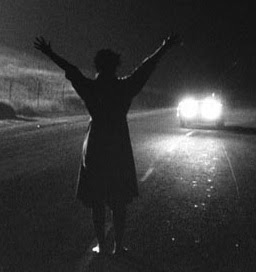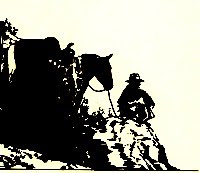Lash LaRue Marshal Cheyenne Davis
Al St. John Sheriff Fuzzy Q. Jones
Ian Keith Doc Peters
Bob Duncan Jack Barton
Story Joseph O’Donnell
Screenplay Patricia Harper
Director Ray Taylor
 Get your popcorn and go to the rest room now before the show starts, so you don’t miss an exciting minute of this one.
Get your popcorn and go to the rest room now before the show starts, so you don’t miss an exciting minute of this one.Opening montage. There’s exciting music, and we quickly find out that there’s a fierce feud going on between the Condons and the Harts over the Blue Girl Gold Mine. Newspaper headlines flash by, and there’s constant gunfire. Bang-bang-bang.
Men on horseback chase a wagon until it goes over a cliff into the water. A man is shot from a horse and rolls down a steep embankment. In a night-time scene, men behind rocks are shooting at another horse-drawn wagon. We see it roll into town, the driver hunched over, hit. One man falls from the speeding wagon and the wagon goes over a cliff and crashes in a cloud of dust. Crash!
First scenes. A sign tells us that we’re at the Mesa City sheriff’s office. It’s a closeup of the sheriff facing a concerned Cheyenne, who sits across from him, “You walked right into the trap I baited for you, Cheyenne.”
Cheyenne says, “It’s not the first trap I’ve sprung or I escaped from, Sheriff.”
The Sheriff says, “You’ve reached the end of your rope.”
Turns out they’re playing checkers, and the Sheriff wins the game. Ha-ha.
A bright lamp is glowing over the table and there is a pair of longhorns mounted on the wall behind them. Two men have been watching the game. Cheyenne is wearing his black shirt. He looks confident, barely smiles. He’s been winning every match until now.
There’s a letter just arrived on the stage from Sheriff Fuzzy Jones in Red Gulch, Nevada. Fuzzy says the Condons and the Harts are feuding and he’s asking for help. When the Sheriff hears Fuzzy is in Red Gulch, he says he’s just picked up a killer by the name of “Tiger” who was on his way there to make trouble. He was carrying a letter introducing him to a Jack Barton.
Cheyenne gets up to leave for Red Gulch. He’s dressed completely in black, with a black hat. He has two pistols in his silver-studded holsters and gun belt.
















































